The Kenyan government has announced new restrictions on official vehicles allocated to government officials, aiming to enhance fiscal responsibility and uphold a commitment to austerity measures.
The proposals, outlined in the 2024 Government Transport Policy and drafted by Treasury Cabinet Secretary John Mbadi, will significantly reduce the number of vehicles allocated to senior officials and set stringent guidelines on the types and capacities of vehicles used in government functions.
Under the proposed policy, each Cabinet Secretary will be limited to two vehicles, while each Principal Secretary will have one vehicle allocated for official duties. Specific limits have also been set for engine capacities: saloon cars cannot exceed 2,600 cubic centimeters (CC) and 4×4 utility vehicles are capped at 3,000 CC.
The policy further stipulates that heads of parastatals, Chief Executives of independent commissions, and State corporation chairpersons will each be assigned a single vehicle. Meanwhile, senior officers will share from a designated pool of vehicles, and members of parastatal boards using personal vehicles for official duties will be reimbursed.
County officials are also affected, with governors limited to two vehicles, while deputies and County Executive Committee members will each receive a single vehicle. For high-ranking officials, including those at Job Group R and above, High Court judges, and CEOs of State corporations, vehicles will be restricted to 2,000 CC for saloon models and 2,900 CC for 4×4 utility models.
In response to rising government spending on vehicle fleets—escalating from Ksh.8.6 billion in 2021 to Ksh.14.3 billion in 2023—the Treasury says these steps are essential for fiscal prudence. Additionally, Ksh.12.2 billion was earmarked for the procurement and maintenance of new vehicles in the 2023/24 fiscal year.
The policy also prohibits private number plates on government vehicles, except for security purposes. Any government official seeking to use private plates must seek authorization from the Head of Public Service, signaling a move toward greater transparency in government transport usage.














